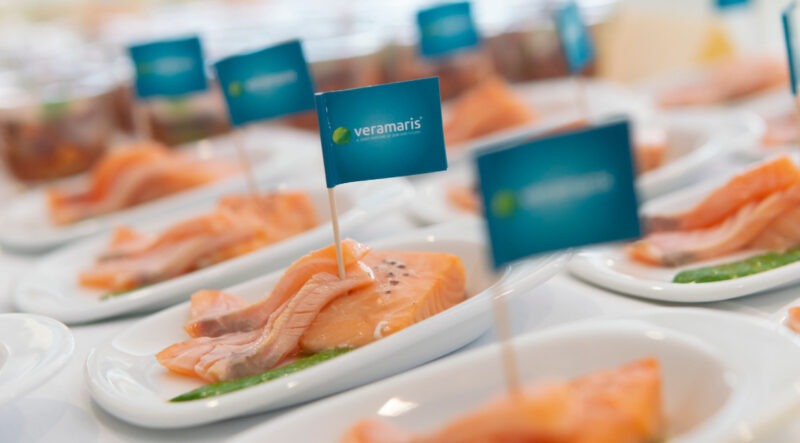Aquaculture making clear headway for alternative feed ingredients
Seafood farmers are using diverse protein ingredients to improve feed security for more sustainable aquaculture.
By SeaWestNews
A new study says the aquaculture industry is getting better at using diverse protein ingredients, but still needs to figure out how to scale up new resources to meaningful volumes.
The review, by the Marine Ingredients Organisation (IFFO) suggests opportunities for complementarity and improving feed security for more sustainable aquaculture.
With various new feed ingredients emerging in the aquaculture feed sector, the publication provides “sobering assessments” of the current status of the search for new protein sources, stated the Global Seafood Alliance (GSA).
The review considers a large variety of protein sources used in aquafeeds, including:
- Marine ingredients, which are produced from either forage fishery or by-products from both fishery and aquaculture resources.
- Processed animal proteins, made from terrestrial animals produced for human consumption from which by-products are generated, as well as insect and worm meals.
- Single-cell protein resources, produced from bacterial, yeast, fungal or microalgal origins.
- Grain protein sources, which make up the largest volume of all global aquafeeds. These include cereals, oilseeds, pulses, including those plant resources, used either unmodified or with varying degrees of processing.
“The assessment demonstrates that every ingredient has strengths and weaknesses,” said IFFO’s Technical Director, Dr. Brett Glencross, who led the review with a cohort of world-renowned fish nutritionists.
“In many cases, the weaknesses of one ingredient can be matched with the strengths of other ingredients to identify opportunities for complementarity,” he said.
For example, soybean is widely available, and its quality is consistent, but many fish species don’t find it appealing. Fishmeal, on the other hand, is appetizing to fish but it’s limited in supply. However, when used together, they can complement each other.
The review provided a series of clear options to improve feed security, including improved management of existing resources to increase their productivity and ensure nothing is wasted. It also recommended further developing non-competing resource production.
“By better appreciating the positives and negatives of each ingredient, it becomes possible to increase our adaptability in responding to the various opportunities for their use in feeds and improve our sustainability of the sector moving forward,” said Glencross.
Meanwhile, the Canadian Aquaculture Industry Alliance (CAIA) said it welcomes the news that Netherlands-based Veramaris has been granted the first market authorization in Canada for the inclusion of algal oil in feeds for salmonid species after a three-year registration process.
The authorization allows Veramaris to provide Canada’s salmon farmers with EPA (eicosapentaenoic acid) and DHA (docosahexaenoic acid) — nutrients essential for fish health and welfare and the nutritional value of farm-raised seafood.
Veramaris algal oil is produced in Blair, Nebraska, USA, to support the industry’s adoption of alternative omega-3 fatty acid sources and reduce its dependency on marine ingredients like fish oil and fishmeal.
“The Canadian registration of Veramaris’ algal oil is key to supporting the rising global demand for alternative sources of omega-3 EPA and DHA. Securing authorization in Canada is an important step not only for Veramaris but also for the entire aquaculture industry,” said Gertjan de Koning, CEO of Veramaris.
Tim Kennedy, president and CEO of CAIA said “Veramaris’ algal oil brings us closer to achieving our sustainability aspirations.”
“This registration not only highlights the strategic value of aquaculture in Canada but also demonstrates the industry’s commitment to innovation and environmental stewardship.”
Earlier this month, the Global Salmon Initiative (GSI) in partnership with World Wildlife Fund (WWF) launched a first of its kind environmental, social, governance (ESG) risk assessment tool for feed ingredients to support the salmon farming and other protein producing sectors.
The tool will improve visibility into supply chains, allowing stakeholders to better identify and address possible ESG risks.
The tool, developed over a three-year period in consultation with the GSI members, WWF, and industry feed companies, is the first time a common methodology is available to support greater alignment in feed data collection.
“Feed ingredient sourcing remains one of the main sustainability challenges in salmon farming, and food production more broadly,” said Daniel Miller, aquaculture lead specialist at WWF.
“This tool isn’t designed only for farmed salmon, or even just aquaculture, we see it having critical impact across the animal protein production sectors, and even pet feed, that all share many of the same supply chains and risks,” he said.
Tor Eirik Homme, Director of Feed and Nutrition, Grieg Seafood said the common tool enables producers to all ask the same questions of the supply chain which will streamline requests and improve the level of traceability, ultimately supporting accelerated improvements in the sustainability of the ingredients being used for feed.
The Aquaculture Stewardship Council (ASC) has also reviewed the tool and intends to incorporate it as one of its due diligence mechanisms to be part of the ASC Feed Standard certification process.
In addition to the tool, WWF in collaboration with GSI and Grieg Seafood, released a business case, Feed of the Future: Transparent and Traceable. The paper outlines the challenges inherent in feed production, the development of the tool, and Grieg Seafood’s experience applying it to their supply chain.
Salmon farmers are the world’s top protein producers by the Coller FAIRR Protein Producer Index, a global service that ranks companies in responsible food production.
Its latest report found that aquaculture companies, primarily salmon companies, continue to perform better than land animal protein producers.
“Aquaculture companies continued to outperform land-based protein producers on all risk factors. They recorded a 9% increase in average score, with every risk factor seeing a rise in performance – especially deforestation, water use and scarcity, animal welfare and governance,” the report said.
The Index provides financial institutions with best-in-class data, analytics and trends related to the protein sector, helping inform investment decisions and engagement strategies.
The report said aquaculture continues to be the food-producing sector with the highest annual growth rate.
(Image courtesy of Veramaris)

